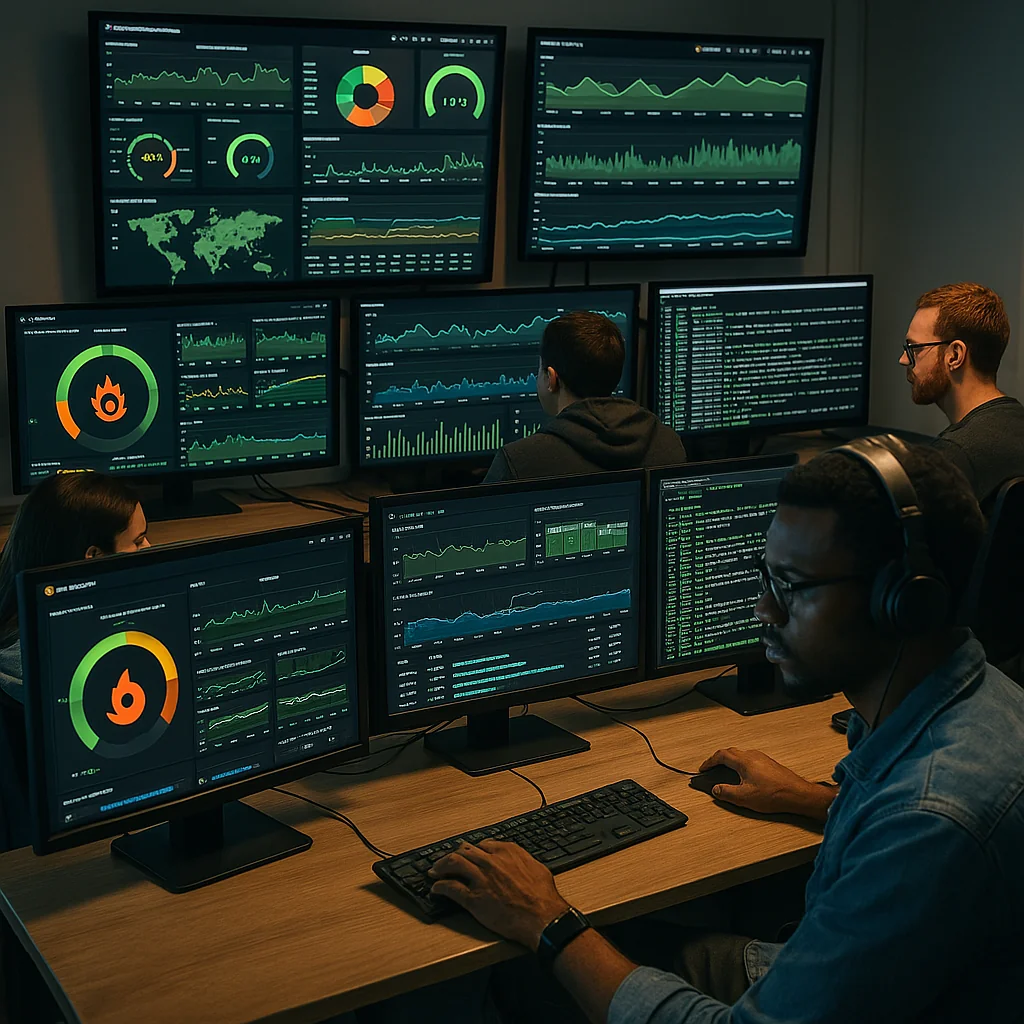Ever wondered how tech companies keep their systems running 24/7? It's through monitoring and logging.
In modern DevOps, observability is non-negotiable — and it starts with robust monitoring and logging. Professionals often debate between ELK Stack vs Prometheus Grafana and Grafana Loki vs ELK when choosing their tools.
In this 2025 guide, we’ll explore four of the most widely-used tools: Prometheus, Grafana, ELK Stack, and Loki.
We also tackle common comparisons such as Prometheus Grafana vs ELK and ELK vs Grafana Loki so you can confidently choose the best solution.
Whether you're deploying microservices or managing infrastructure at scale, this article will help you understand the differences, benefits, and best practices for choosing and integrating these observability tools into your tech stack.
Want to Master Monitoring Tools Like Prometheus and ELK? Join Refonte’s hands-on DevOps Engineering Bootcamp — learn observability tools, CI/CD, Docker, and cloud deployment.
Why Monitoring & Logging Matter in DevOps (2025 Trends)
Growing Adoption: Monitoring and logging are core parts of “observability,” a trending concept in DevOps. Tools like Prometheus and Grafana have become de-facto standards – three-quarters of survey respondents use Prometheus in production, indicating how prevalent it is in modern cloud environments (often alongside Kubernetes). The ELK Stack remains widely used for log analytics due to its flexibility and scalability, though newer solutions like Grafana Loki are gaining traction for their cost-efficiency.
Prometheus + Grafana Synergy: Prometheus (for metrics collection) and Grafana (for visualization) are commonly paired. Many organizations use Prometheus to scrape metrics and Grafana to create dashboards and alerts, fulfilling the monitoring aspect of observability. This trend is driven by the need for real-time insight into system health.
Logging Evolution (ELK to Loki): ELK Stack (Elasticsearch for search, Logstash for ingestion, Kibana for visualization) has been a go-to logging solution. However, the emergence of Loki offers a more lightweight approach to logs: Loki is designed to be cost-effective and easy to operate, indexing only labels instead of the full log text. This addresses a common concern that traditional ELK setups can become resource-intensive and costly for large volumes of logs. Many DevOps teams are now exploring Loki, especially in cloud-native setups, as it integrates seamlessly with Grafana and mimics Prometheus’s model for logs.

Monitoring vs Logging: What’s the Difference?
Monitoring refers to real-time tracking of system performance (e.g., CPU, memory, request rates), while logging is the recording of events and messages for later analysis.
Understanding the differences helps in the comparison of ELK Stack monitoring tool capabilities versus the popular combination of Prometheus Grafana ELK Stack.
Monitoring can trigger alerts instantly, while logging (with tools like ELK Stack Udemy courses often highlight) is essential for retrospective issue diagnosis.
While monitoring, especially with tools like Prometheus logging, allows immediate alerting when thresholds are breached, logging solutions enable detailed retrospective analysis. Understanding their interplay is crucial for effective system management.
Why They Matter in DevOps
With modern applications scaling to thousands of users, robust monitoring and logging isn’t optional—it’s necessary to meet uptime SLAs and quickly troubleshoot incidents. This explains why comparing ELK vs Prometheus Grafana is common among engineers deciding on observability stacks.
According to industry trends, teams frequently evaluate ELK Stack vs Grafana Loki due to differences in scalability, costs, and complexity.
Overview of Key Tools:
1- Prometheus for Time-Series Monitoring
Prometheus is a powerful time-series monitoring system great for tracking metrics like CPU usage or request latency in real time. It excels at Prometheus logging by alerting Cloud Engineers when thresholds are crossed.
Many beginners explore comparisons such as Elasticsearch vs Prometheus and ELK vs Grafana and Prometheus to decide whether Prometheus monitoring fits their needs, particularly given Prometheus’s strength in numeric data versus ELK’s focus on logs
2- Grafana for Dashboards & Alerting
Grafana provides beautiful dashboards for your metrics—if Prometheus collects data, Grafana visualizes it. Grafana dashboards are central to comparisons like ELK stack vs Prometheus Grafana because Grafana integrates seamlessly with Prometheus metrics.
This ease of integration often sparks debates about ELK Prometheus Grafana setups, as Grafana can visualize data from Prometheus and ELK, offering unified views that many beginners appreciate
3- ELK Stack: Deep Log Analysis
The ELK Stack—Elasticsearch (searchable database for logs), Logstash (data ingestion), Kibana (visualization)—specializes in log management and analysis. ELK remains popular among learners exploring Udemy ELK courses because of its detailed indexing and powerful search capabilities.
While often compared in Grafana Loki vs ELK discussions, ELK’s comprehensive log indexing makes it preferable when complex queries matter. Think of ELK as a ‘Google’ for your logs, widely trusted for thorough searches.
4- Loki: Lightweight Logging with Grafana
Loki is the new kid on the block for logging, offering a lightweight alternative to ELK. Unlike ELK, Loki indexes metadata rather than entire logs, significantly reducing cost. This cost-effectiveness often drives comparisons like ELK Stack vs Grafana Loki.
When considering log monitoring Prometheus methods or exploring how Prometheus monitoring logs differ from Loki’s approach, it's clear Loki closely mirrors Prometheus’s philosophy of efficient metadata indexing
Monitoring & Logging Best Practices (2025 Guide)
A beginner-friendly tutorial can show how to set up a simple monitoring stack using Prometheus and Grafana—commonly compared to the traditional ELK Stack monitoring tool setup.
Learning via practical guides, such as those found in ELK Stack Refonte Learning courses, helps beginners implement Prometheus Grafana ELK Stack strategies quickly.
For beginners eager to implement these concepts, setting up a simple observability stack using Prometheus and Grafana can be straightforward:
Install Prometheus (via Docker for simplicity).
Connect Grafana to Prometheus.
Begin collecting data using a metric exporter like Node Exporter.
Import or create dashboards in Grafana to visualize real-time data.
Similarly, log management setups can be achieved by:
Choosing between ELK Stack vs Grafana Loki based on log volume and complexity.
Configuring ELK or Loki to ingest logs from your application.
Visualizing and querying logs via Kibana (ELK) or Grafana (Loki).
Best Practices & Pro Tips
Correlating metrics and logs is essential, as metrics indicate symptoms (high CPU usage), while logs provide the cause (error details). This synergy emphasizes the importance of carefully evaluating Prometheus Grafana vs ELK or even ELK vs Grafana Loki.
Managing storage effectively (e.g., via log rotation in ELK or metadata indexing in Loki) also impacts tool choice, driving teams to consider ELK Stack vs Grafana Loki carefully.
Here's a brief summary of these practices:
Correlate Metrics and Logs: Metrics indicate problems (like high CPU usage), while logs provide deeper insights (specific errors). This reinforces the importance of exploring Prometheus Grafana ELK Stack integrations.
Thoughtful Alerting: Avoid alert fatigue by setting meaningful alerts in Prometheus and Grafana, carefully informed by insights from logging solutions like ELK.
Efficient Log Management: Optimize storage and cost by considering solutions like Loki’s metadata-only indexing versus comprehensive indexing provided by ELK.
Dashboard Storytelling: Create Grafana dashboards that clearly communicate system health, aligning closely with business KPIs.
Experts recommends these best practices in its DevOps monitoring workshops to ensure students build efficient, real-world systems.
DevOps Career Tips: Learn Monitoring Tools Fast
Modern DevOps roles regularly seek skills in ELK Prometheus Grafana due to these tools’ widespread adoption. Online courses have surged in popularity, reinforcing the importance of understanding comparisons like ELK Stack vs Prometheus Grafana for career growth.
Professionals who master observability, including Prometheus monitoring logs and ELK’s log management capabilities, become highly sought-after.
Job postings frequently highlight skills in tools like ELK Prometheus Grafana, reflecting their importance in maintaining high-availability systems.
Refonte Learning offers practical, hands-on projects—such as deploying live Grafana dashboards monitoring real applications—making observability skills immediately applicable.
Conclusion
Monitoring and logging form the backbone of reliable IT systems. Tools like Prometheus, Grafana, ELK, and Loki empower beginners to build powerful observability stacks.
Understanding common debates such as ELK Stack vs Prometheus Grafana, Grafana Loki vs ELK, or Elasticsearch vs Prometheus helps clarify the best starting point.
To deepen your skills, explore Refonte Learning DevOps Engineering course covering cloud monitoring and logging, and soon you'll be diagnosing issues like a pro.
FAQs About DevOps Monitoring Tools
Q: What’s the difference between Prometheus and Grafana?
A: Prometheus is a backend monitoring tool that collects and stores metrics. Grafana is a front-end visualization tool that displays those metrics in dashboards and graphs.
Q: Can ELK Stack be used for monitoring?
A: ELK is primarily for logging (it excels at analyzing log data). For monitoring metrics, tools like Prometheus (or alternatives like Graphite) are more suited. However, Kibana (part of ELK) can be used for visualizing metrics if data is fed into Elasticsearch.
Q: Is Loki a replacement for ELK?
A: Loki is a newer solution focusing on efficiency and easy integration with Grafana. It can replace ELK in certain use-cases (especially Kubernetes-centric logging), but ELK might still be better for heavy-duty log analysis or where full-text search is needed.
Q: What is the difference between Prometheus and ELK Stack?
A: Prometheus is a metrics monitoring tool, while ELK Stack is focused on logging and log analysis. Prometheus handles real-time metrics, while ELK is ideal for in-depth log searches.
Q: Is Grafana used with Prometheus or ELK?
A: Both. Grafana visualizes data from Prometheus and ELK, allowing engineers to create unified dashboards for metrics and logs.
Q: What is Loki and how is it different from ELK?
A: Loki is a lightweight, log aggregation tool that indexes only metadata — making it more cost-efficient than ELK, which indexes full logs.
Q: Which stack is best for observability in 2025?
A: It depends on your use case. Use Prometheus + Grafana for metrics, ELK for detailed log analysis, and Loki for scalable logging with Grafana integration.
